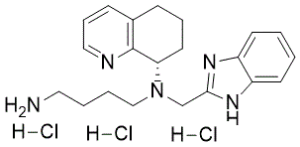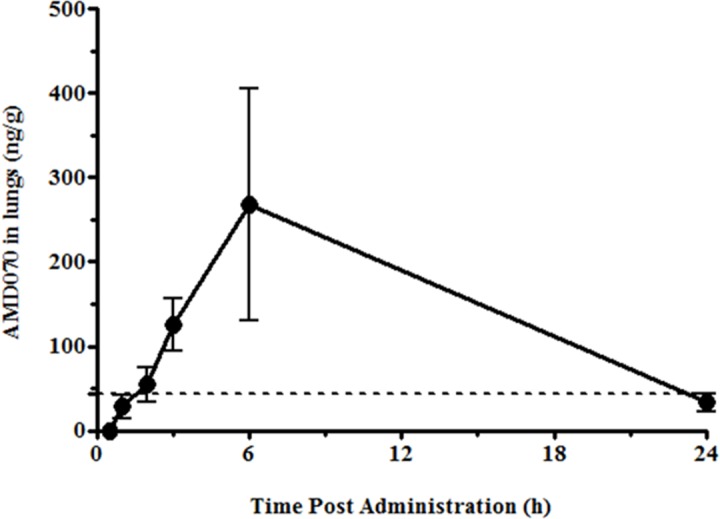This product is for research use only, not for human use. We do not sell to patients.

| Size | Price | Stock |
|---|---|---|
| 5mg | $140 | 3-6 Days |
| 10mg | $220 | 3-6 Days |
| 25mg | $400 | 3-6 Days |
| 50mg | $650 | 3-6 Days |
| 100mg | $1050 | 3-6 Days |
| 250mg | $1650 | 3-6 Days |
Cat #: V3259 CAS #: 880549-30-4 Purity ≥ 98%
Description: Mavorixafor triHCl (also known as AMD-1107, AMD070, X4P-001) is a potent, selective and orally bioavailable antagonist of CXCR4 with anti-HIV activity. It inhibits CXCR4 with an IC50 value of 13 nM in a CXCR4 125I-SDF inhibition binding assay, also inhibits the replication of T-tropic HIV-1 (NL4.3 strain) in MT-4 cells and PBMCs. The CXC chemokine receptor CXCR2 is upregulated in a variety of different tumor cell types and involved in tumor cell proliferation and progression. Inhibition of CXCR2 led to reduced metastasis and decreased tumorigenesis. As a CXCR2 antagonist, SX-682 has the potential to treat cancer. AMD-070 has been evaluated in phase I/II studies in different solid tumors by X4 Pharmaceuticals. This compound also has the potential use for the treatment of HIV-1 infection.
Publications Citing InvivoChem Products
Product Promise

- Physicochemical and Storage Information
- Protocol
- Related Biological Data
- Stock Solution Preparation
- Quality Control Documentation
| Molecular Weight (MW) | 458.86 |
|---|---|
| Molecular Formula | C21H30Cl3N5 |
| CAS No. | 880549-30-4 |
| Storage | -20℃ for 3 years in powder form |
| -80℃ for 2 years in solvent | |
| Solubility In Vitro | DMSO: >10 mM |
| Water: NA | |
| Ethanol: NA | |
| SMILES Code | NCCCCN(CC1=NC2=CC=CC=C2N1)[C@H]3CCCC4=C3N=CC=C4.[H]Cl.[H]Cl.[H]Cl |
| Synonyms | X4P-001 3HCl; AMD 11070 3HCl; AMD-070 3HCl; X4P 0013HCl; AMD-11070 3HCl; AMD 070 3HCl; X4P001 3HCl; AMD11070 3HCl; AMD070 3HCl; mavorixafor 3HCl |
| Protocol | In Vitro | In vitro activity: AMD-070 is active against X4 strain of HIV-1, HIV-1 IIIb in MT-4 cells, and The IC50 values for AMD-070 are 9-fold higher (0.009 μM vs 0.001 μM) and 8.7-fold higher (0.003 μM vs 0.026 μM) in PBMCs compared to MT-4 cells. AMD-070 has antiviral ability with the IC50 value of 15.5 nM. Kinase Assay: SUP-T1 T cells are first preincubated with the compounds (with 1 as a control) for 30 min on ice, washed with PBS with 2% FCS, and incubated with PE-conjugated anti-CXCR4 mAb for 30 min on ice. After being washed with PBS, the cell samples are fixed with 1% paraformaldehyde in PBS and analyzed on a FACS Calibur flow cytometery. The dose-dependent inhibitory effects of the compounds on mAb binding are determined using the mean fluorescence intensity values. Cell Assay: he activated cells (PHA-stimulated blasts) are washed three times with PBS, and viral infections are done. HIV-infected or mock-infected PHA-stimulated blasts are cultured in the presence of 25 U/mL of IL-2 and varying concentrations of compounds. Supernatant is collected at day 10, and HIV-1 core antigen in the culture supernatant is analyzed by the p24 viral Ag ELISA kit. Inhibition of HIV-1 replication in MT-4 cells is performed as previously described. Anti-HIV-1 activity and cytotoxicity measurements are carried out in parallel. They are based on the viability of MT-4 cells that has been infected with HIV-1 in the presence of various concentrations of the test compounds. The ICsub>50 is defined as the concentration required to inhibit 50% of the virus-infected cells against viral cytopathicity. |
|---|---|---|
| In Vivo | AMD-070 shows promising oral bioavailability in rat and dog. The rate of clearance is species dependent with AMD-070 having lower clearance in dog compared to rat. | |
| Animal model | Rat |
| Solvent volume to be added | Mass (the weight of a compound) | |||
|---|---|---|---|---|
| Mother liquor concentration | 1mg | 5mg | 10mg | 20mg |
| 1mM | 2.1793 mL | 10.8966 mL | 21.7931 mL | 43.5863 mL |
| 5mM | 0.4359 mL | 2.1793 mL | 4.3586 mL | 8.7173 mL |
| 10mM | 0.2179 mL | 1.0897 mL | 2.1793 mL | 4.3586 mL |
| 20mM | 0.1090 mL | 0.5448 mL | 1.0897 mL | 2.1793 mL |
This equation is commonly abbreviated as: C1 V1 = C2 V2
- (1) Please be sure that the solution is clear before the addition of next solvent. Dissolution methods like vortex, ultrasound or warming and heat may be used to aid dissolving.
- (2) Be sure to add the solvent(s) in order.





































